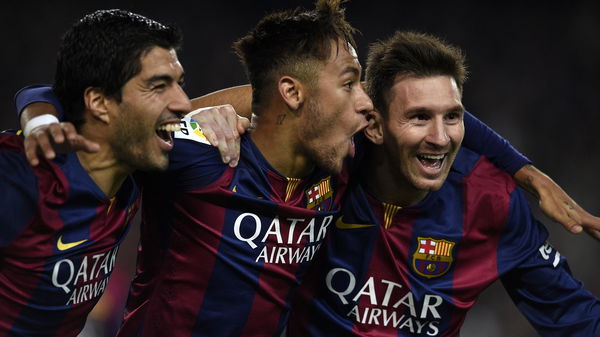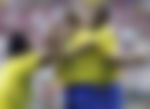


ADVERTISEMENT
Article continues below this ad
Is ‘MSN’ the best attacking trio ever? Well, these next few players might just disagree! Throughout history, football has seen some brilliant partnerships. Are MSN right up there with them or is it too early to say? Find out for yourself!
What forms a great partnership?
Is it the chemistry partners share? Or perhaps the answer is more result oriented with the number of medals the deciding factor? The depth of understanding of each other’s game-play among the members of a partnership certainly is a contributing factor. The accolades the team receives as a direct consequence of the partnership also cannot be discarded.
Some middle ground is required here as both possibilities carry equal weightage. The Barcelona attacking trio of Lionel Messi, Luis Suarez and Neymar Jr. is being heralded as the best attacking partnership the world has seen. They undoubtedly share great on-field chemistry. The ‘MSN’ trio has also got the required results, scoring over 120 goals collectively this season. Barcelona have already won the La Liga and the Copa del Ray. With the UEFA Champions League Final fast approaching, questions are being raised about how the MSN trio compares with some of the greatest attacking trios ever seen.
To attempt to compare attacking trios across generations is an ill-advised task. Times change, the game evolves along with the incentive to play football. The involvement of the coaching staff has also increased over the years with development in technology contributing to increased scrutiny and analysis of game-plays, thus enabling footballers to play better football. However, if a comparison has to be made, it becomes necessary to identify the greatest attacking trios the world has ever seen and rationalize whether MSN falls into that bracket. Yet.
So, sit back and read as Essentially Sports’ brings you the list of the best attacking trios to ever grace the game and for the question of whether MSN are up there with them, You be the Judge!
Hungary, 1950-54 (The Mighty Magyars)
Nandor Hidegkuti, Ferenc Puskas, Sandor Kocsis

From May 1950 to July 1954, the Hungarian national team was undefeated. That’s FOUR YEARS without tasting defeat! This should stand testament to the incredible ability of one of if not the best football team the world has ever seen. Statistically, with a goal per game ratio of 0.99 and 1.103, it can be argued that the attacking strike force of Ferenc Puskas and Sandor Kocsis is the best ever. These central strikers were supported by Nandor Hidegkuti who played the role of the withdrawn forward, effortlessly dropping into pockets and creating space for Puskas and Kocsis.
Hungary won the Olympic title in 1952 and were favourites to win the World Cup of 1954. However, injury to Ferenc Puskas kept him out of most of the tournament.
Even without their star striker, they reached the finals where they erroneously played the unfit Puskas. West Germany, who had earlier been beaten by the Mighty Magyars by a whopping 8-3, crawled their way to a 3-2 victory after a Puskas effort was incorrectly ruled offside and Kocsis was denied a clear penalty in the final minute. The match is called the Miracle of Berne.
That match was their only loss in a period of 7 years from 1950 to 1956. The team broke up after the Hungarian uprising of 1956 and several players moved abroad. The quality of football in Hungary gradually declined and has never been close to reverting back to its glory days.
Real Madrid, 1955-60
Alfredo Di Stefano, Ferenc Puskas, Francisco Gento

With 5 consecutive European Cup victories and unmatched domestic dominance, the Real Madrid team of the late 1950s is undoubtedly one of the greatest to grace the football field. In an era with no sponsors, no agents, no television coverage, these men played football purely for the pleasure of doing so and in the process, set up the foundation for football as we know it.
The tactical formation of 3-2-5 was designed to utilize the attacking talents that Madrid had at its disposal. The spearhead of the attack and (arguably) their star man, Alfredo Di Stefano was their leader. A star predator who scored 216 times in 284 La Liga games. He also dropped deep into midfield and invented the role of the target man, linking brilliantly with his teammates. Signed at the age of 27, he would go on to be the Madrid stalwart for years to come.
Di Stefano’s attacking partner was Ferenc Puscas who defected from communist Hungary and joined Real Madrid at the age of 31. He was gifted with an incredible left foot and occupied the space Di Stefano left vacant during his backward forays. He famously scored four goals in what some argue is the greatest attacking performance by any football team in the 7-3 victory against Eintracht in the 1960 European Cup Final. The other three were scored by Di Stefano.
Complementing these two goal machines was Francisco Gento who remains the only footballer to have won 6 European Cups. The left winger was the perfect supplier to Di Stefano and Puskas with his dazzling runs down the left. Gento played for Real Madrid for almost 20 years with 12 La Liga titles along the way.
This Real Madrid squad revolutionized football and influenced future pioneers of the game. Michel Platini summarizes the influence exerted by Alfredo Di Stefano and his Real Madrid teammates and says, “Together with his gifted teammates, Di Stefano helped invent modern football. He embodied all that is magical about the game.”
Manchester United, 1968 (The Holy Trinity)
George Best, Denis Law, Bobby Charlton

Manchester United are a football club with unparalleled richness of history. It is arguably the biggest football club in the world at the moment with a fan base spanning 6 continents. The foundation upon which this footballing dynasty was built is shrouded in tragedy. After the Munich disaster, the club was in shambles. Through the persistence of the club management and support of the global football fraternity, Manchester United rose again to unfathomable heights. Their rise from the ashes culminated into the European Cup title of 1968 after 6 years of domestic dominance.
The brand of football played under Sir Matt Busby was high tempo, fast, and energetic. Manchester United played exciting football with the trio of George Best, Denis Law, and Bobby Charlton seemingly unstoppable in their prime. The trio were nicknamed the ‘Holy Trinity’. Bobby Charlton was a midfield goal-scoring machine and holds the record for the maximum goals for the club.
Denis Law was a natural predator with an uncanny eye for goal and topped the goal-scoring charts for United multiple times in this period. George Best was arguably the best footballer player the world has ever seen, at par with Diego Maradona and Pele, and very often single-handedly turned the game on its head. An absolute joy to watch, Best had limitless talent matched only with his materialistic desires.
Together, the Ballon D’Or winners dominated opponents in a manner that has not been seen at the club since their departure. The statue of the three stalwarts watching over the United faithful outside Old Trafford is living reminder of what the club owes them.
Brazil, 1970
Pelé, Jairzinho, Tostao

via Imago
Pele with Jairzinho
There few things in football more appealing than a Brazilian team making their opponents dance to their Samba magic. Over the years, the football universe has had the fortune to witness several generations of Brazilian attackers waving their magic wands and casting spells on defenders. In the 1970 World Cup in Mexico, the world truly witnessed Samba magic in full flow.
With an extremely solid defensive and midfield foundation, the Brazilian trio of Tostao, Jairzinho and Pelé wreaked havoc and ripped defences to shreds. The sheer intensity and fluidity of the legendry trio took the world by storm. Pelé was directly involved 14 of the 19 goals Brazil scored in the tournament and firmly established his place as the best footballer on the planet. Tostao and Jairzinho, centre forwards in their own right also contributed and it was their intelligent movement that allowed Pelé to flourish as he did. Jairzinho ended up scoring in every single match of the tournament being only the second person to ever achieve that miraculous feat.
This side also perhaps introduced the now commonplace 4-3-3 formation. With Rivelino dropping deep in the capacity of a back-tracking winger (previously unknown to footballers), the versatile front three optimally utilized their many talents and formed a near telepathic understanding of each other’s manner of playing football.
This Brazil side marched their way to World Cup victory and the front three shall forever be remembered for their exquisite football. The 1970 Brazil side is widely considered the greatest team ever to play in the World Cup.
Ajax, 1971-74
Johann Cruyff, Johnny Rep, Piet Keizer

‘Total Football’ is a concept that was first incorporated by manager Rinus Michels who guided Ajax of the early 1970s to unprecedented success. The team was led by Johann Cruyff who at that time was gaining his world-class reputation. Flanked by Johnny Rep on his right and Piet Keizer on his left, Cruyff led the lines of one of only three teams to win Europe’s top honour 3 times consecutively. Ajax won the European Cup in 1971, 1972 and 1973.
Johann Cruyff was a magician. In addition to being technically perfect, Cruyff had the ability to visualize his teammates’ and opponents’ movement and react accordingly. Total Football is based on spatial awareness. Ajax was built around Johann who found the perfect partners in crime in Keizer and Rep. With focus on possession and on field dominance, Ajax found the perfect balance within their squad.
Coach Rinus Michels was then appointed as the Coach of the Netherlands national team which mesmerized the world at the 1974 World Cup. The same Ajax players and style of ‘Total Football’ was beautifully carried on by this side who were undoubtedly the best side of the tournament, only to lose out in the Final to Beckenbauer-led West Germany. Johann Cruyff was awarded the Golden Ball.
Few footballers could have understood the intricacies of Total Football as well as Cruyff who in turn generated his own rendition of the format. This rendition laid the groundwork for possession football as played by Barcelona when Cruyff took over as manager at Camp Nou and then further modified to ‘Tiki-Taka’ under Pep Guardiola. Indeed, this past decade, Barcelona have played some of the most beautiful football ever witnessed and the evolution of their gameplay can largely be credited to Johann Cruyff and the Ajax of the early 1970s.
Bayern Munich, 1972-76
Karl Heinz-Rummenigge, Uli Hoeneß, Gerd Müller

In the 1960s, the Bundesliga was finding its feet. Bayern Munich had initially been a second division side finding its way to the top flight after two seasons of the Bundesliga’s inception. What followed is perhaps football’s greatest rise to power as the Bavarians and the Germans took world football by storm.
Gerd Müller led the lines for Bayern Munich with Uli Hoeneß his primary provider.
After the introduction of a young Rummenigge into the mix, Bayern began to thrive and consequently established themselves as the dominant force in the Bundesliga and European Cup with three successive European titles (1974-76).
Müller was the primary goalscorer. He was a beast in front of goal. His records are by the plenty. During his time with Bayern, Müller scored a mind-boggling 325 goals in 427 matches only in the Bundesliga. He held the record for the most goals in a calendar year (85 goals in 1972), which has since been broken by Lionel Messi.
This period of domination laid the foundation for the German Footballing Empire that we know today. Their influence on the club is still strong with Rummenigge the present club president.
Real Madrid, 1985-89
Hugo Sanchez, Emilio Butragueno, Martin Vasquez

via Imago
Butragueno (extreme left), Sanchez (second from right) and Vasquez (extreme right).
The Spanish can often be scathing of British football. The two different brands of football practiced in the countries form two pillars of football philosophy. The Spanish are to be loved and admired for their ball playing ability while the English are to be feared and respected for their physicality and efficiency. However, when the twain do meet, history is made.
In 1989-90, a John Toshack managed Real Madrid scored 107 goals in a season marking the first time Spanish side entered the 100 club. This Real Madrid squad won its 5th straight La Liga in Toshack’s first season in charge and a lot of the credit goes to their strikers Hugo Sanchez, Emilio Butragueno, and their top scoring midfielder Martin Vasquez. Heralded as the ‘greatest Madrid side since the Puskas-Di Stefano era’, this side achieved what the Galacticos could not – Unprecedented dominance.
While other entries to the list merit a spot for their telepathic understanding with one another, the strike partnership of Sanchez and Butragueno could not be more different. Their relationship was characterized by a strong mutual dislike which was typified by their opposite styles of playing football. Emilio Butragueno was a creative, intelligent forward of slight build, whereas Hugo Sanchez was a prima donna, a striker who would shoot first and think later. Inspite of their on and off field differences, Madrid had a formula that worked. Get the ball into the box. The duo did the rest. Sanchez scored a ridiculous 38 goals in ‘89-90, with Butragueno and Vasquez adding another 10 and 14 in the process.
Brazil, 2002
Rivaldo, Ronaldo, Ronaldinho

The 2002 World Cup shall be remembered for a number of reasons. It marked the growth of football in Asia with hosts South Korea and Japan performing exceedingly well. It shall also be remembered as the first World Cup with a goalkeeper awarded the Golden Ball, with Oliver Kahn imperious throughout the tournament. However, football enthusiasts shall remember the ’02 World Cup for the sheer fluidity displayed by one of the finest attacking trios ever seen (and also for Ronaldo’s bizarre hair-do).
Brazil had struggled throughout qualification and coach Luiz Felipe Scolari had failed to find the right formula. In a stroke of inspiration, Scolari replaced Juninho with Kleberson and thus formed a defensive base upon which Ronaldo, Rivaldo, and Ronaldinho wreaked havoc. With the ever-potent Ronaldo as the spearhead, Rivaldo in close contact, and Ronaldinho carrying the ball forwards from deep, Brazil played fluid, coordinated football which was a joy to behold. Golden boot winner Ronaldo was finally able to fight the demons of his ’98 World Cup past and alongside Rivaldo ripped defences to shreds. However, the star of the tournament was the excellent Ronaldinho and his performances marked the beginning of a footballing legacy that shall forever be cherished.
ADVERTISEMENT
Article continues below this ad
THE VERDICT:

ADVERTISEMENT
Article continues below this ad
Apart from some mesmerizing football, a common feature of all these attacking trios is consistency over seasons. MSN certainly has the potential to fit into that absolute top bracket of footballing partnerships. However, it has to consistently outperform opposition for some years to come to ensure its recognition as one of the greatest attacking trios in world football, ever.
Thus, inspite of a stellar season under their belt, it is a little premature to label MSN with the tag of, ‘Best attacking trio ever’. It would take a number of years of domestic and European dominance to place MSN into that category.
ADVERTISEMENT
ADVERTISEMENT
ADVERTISEMENT
ADVERTISEMENT

